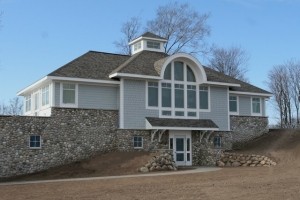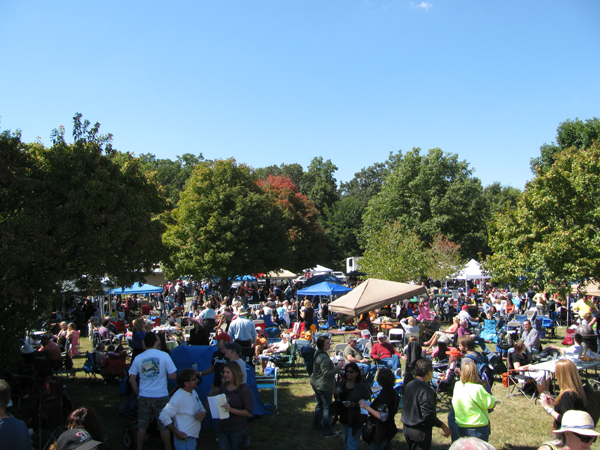Lemberger- A Cold Hardy Vinifera
Hidden among the twenty one varieties and forty acres of vines at Domaine Berrien Cellars and Winery in southwest Michigan is a two acre patch of hardy Austrian grapes known as Lemberger. Owner and winemaker Wally Maurer first encountered this grape in Germany while touring Europe with his father-in-law in the early 1990’s. He says it was his love of wine and the similarity of growing conditions at his Michigan vineyard to that of the Germany that led to his decision to plant the two acres of Lemberger in 1992.
Lemberger, also known as Blaufrankisch, is a dark blue grape that makes dry red wine known for its spicy character. Maurer describes his 2013 vintage as having deep plum flavors with hints of molasses and soft allspice. He adds that it has a ‘blue fruit, blueberry, plum, but not a black fruit taste, and really nice spice characteristics. It’s not as tannic as Cab Sav, and not as meaty.”
Perhaps because of strange name, the wine is a challenging one to sell at Domaine Berrien. Maurer says that it is a hand sell. Tasting room patrons are usually not familiar with it, but will taste it on a whim. Most are impressed with the spice and the tannins.
According to Maurer, the Lemberger in his vineyard benefits from the location of the vineyard to Lake Michigan. The hot and humid conditions of the vineyard produced test batches that exhibited no mildew after rainfall. The vines require a lot of leaf removal due to the size of the leaf, which is large and creates a lot of shading. The grapes are grown on a Scott-Henry Trellis with one bunch of fruit per shoot, which Maurer believes is enough tonnage to stress the vine.
As for the survival of the vines in winter, Maurer says that everything in his vineyard is susceptible. ‘If I make it through this winter, I can get (Lemberger) where I want it.” He adds that Lemberger seems to have more hardiness than Merlot and Syrah. The previous two winters were hard, but he believes the brutal 2015 winter took a heavier toll due to the fact that he took a crop in 2014.
The website for Domaine Berrien describes the winemaking process for their award-winning 2013 Lemberger as ‘cool fermentation using Pasteur Red yeast in stainless steel vats with hand punch-downs twice daily, followed by malolactic fermentation; pressed after 16 day maceration; aged 11 months in Central European & French oak barrels; bottle aged 3 months prior to release.” Tasting notes on the website tell us that this vintage has deep plum flavors with hints of molasses and soft allspice, as well as floral notes of violets on the nose.
Farther north on the Old Mission Peninsula, Hawthorne Vineyards is growing a half acre of Lemberger on their 80 acre site. According to tasting room manager Jan Van Maanen, they were able to produce 90 cases of the wine in 2013, which she described as a bumper crop. This is up from the 50 cases of Lemberger that they usually average.
Maanen says that the majority of people that visit the tasting room are unfamiliar with the wine. ‘Once we explain the origin of the grape, the tasting profile, and the limited availability on the Old Mission Peninsula appellation, it peaks their interest to taste.”
She adds that some of the guests that are familiar with Lemberger will order it by the case since they know it will sell out rather quickly. Lemberger is considered one of their premium wines, and therefore she believes it sells really well.
Hawthorne Vineyard’s website details the winemaking process for their 2013 vintage as: ‘Tank fermented and pressed to the barrels for minimal handling of the wine as it goes into malolactic fermentation. The aging allows for the wine to take up a soft elevated structure. The barrels are topped with Merlot to round out the wine and integrate the blend.”
The finished product is described as a bold wine with plenty of black pepper, dark forest fruit, and raspberry characters. There are raspberry notes that blend with the characteristic of black pepper. Oak aging adds what Hawthorne’s website describes as a mocha toast complexity.
According to Bruce Bordelon, Viticulture Professor at Purdue University in Indiana, Lemberger produced a lower yield than other red grape varieties that he tested.
The trial, conducted at Purdue’s Southwest Agriculture Center in Vincennes Indiana, included Cabernet Sauvignon, Cabernet Franc, Petite Verdot, Tannat, and Lemberger.
In his research, he has found that the fruit quality for Lemberger is good, but high brix levels are seldom reached due to what he believes to be the locations warm site. He says that the wine quality is excellent.
The average harvest date for this study has been September 1, with 12.1 pounds of fruit per vine, and an average brix and pH of 20.6 and 3.44, respectively. The average TA is 7.1. Other information provided by Dr. Bordelon includes averages on cluster weight (146.7g), berry weight (1.60g), vine size (2.7 lb/per plant), and crop load ratio (3.8).
A Wikipedia search for Lemberger immediately redirects to Blaufrankisch. According to the site, the first documented appearance of the grape did not occur until 1862 during a viticultural exposition in Vienna, Austria. It has likely been around as long as the Middle Ages and may have been known under various synonyms.
In the Midwest, it’s known as Lemberger. The wine may still be unknown by most people, but is well liked by those that know it. It is a grape that seems to be a marketing challenge and varies in yield from site to site. Regardless, Midwestern wineries are producing award winning Lemberger. For example, Michigan’s Tabor Hill Winery won three consecutive Gold Medals at the Finger Lakes Wine Competition for their Lemberger.






Informative, I’m trying my first batch with lemberger from Parideso del sol.